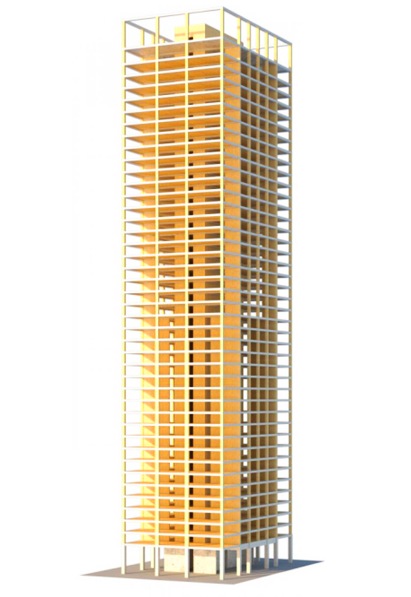In a report released today, Skidmore, Owings & Merrill discussed the results of the Timber Tower Research Project: an examination of whether a viable 400-ft, 42-story building could be created with timber framing. The prototype created by SOM incolves a combination of mass timber, concrete, and steel and was sponsored by the Softwood Lumber Board. Benchmarked against Chicago's DeWitt Chestnut Apartments—a concrete-framed facility considered revolutionary when SOM designed it in 1965—the Timber Tower represents a carbon-footprint reduction of 65% to 75%.
Tall buildings that embody conventional concrete and steel structural design usually have a higher carbon footprint than low-rise buildings, on a square-foot basis. SOM's experiment explores whether tall wood-framed buildings are feasible, justfying changes in contemporary building codes that generally limit the height of such buildings. "Building tall creates desirable urban density, but this solution helps us achieve this result with a much smaller carbon footprint," says SOM Structural and Civil Engineering Partner William F. Baker, PE, Se, FASCE, FIStructE.
SOM staff predict further developments, including possible building code adjustments, based on the research.
(http://archinect.com/news/article/74511379/som-releases-timber-tower-research-project)
Related Stories
| Dec 12, 2011
Mojo Stumer takes top honors at AIA Long Island Design Awards
Firm's TriBeCa Loft wins "Archi" for interior design.
| Dec 10, 2011
10 Great Solutions
The editors of Building Design+Construction present 10 “Great Solutions” that highlight innovative technology and products that can be used to address some of the many problems Building Teams face in their day-to-day work. Readers are encouraged to submit entries for Great Solutions; if we use yours, you’ll receive a $25 gift certificate. Look for more Great Solutions in 2012 at: www.bdcnetwork.com/greatsolutions/2012.
| Dec 10, 2011
Energy performance starts at the building envelope
Rainscreen system installed at the west building expansion of the University of Arizona’s Meinel Optical Sciences Center in Tucson, with its folded glass wall and copper-paneled, breathable cladding over precast concrete.
| Dec 10, 2011
Turning Balconies Outside In
Operable glass balcony glazing systems provide solution to increase usable space in residential and commercial structures.
| Dec 10, 2011
BIM tools to make your project easier to manage
Two innovations—program manager Gafcon’s SharePoint360 project management platform and a new BIM “wall creator” add-on developed by ClarkDietrich Building Systems for use with the Revit BIM platform and construction consultant—show how fabricators and owner’s reps are stepping in to fill the gaps between construction and design that can typically be exposed by working with a 3D model.
| Dec 9, 2011
BEST AEC FIRM 2011: Chapman Construction/Design
Taking sustainable practices to heart.
| Dec 9, 2011
BEST AEC FIRMS 2011: EYP Architecture & Engineering
Expertise-Driven Design: At EYP Architecture & Engineering, growing the business goes hand in hand with growing the firm’s people.
















